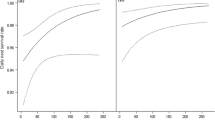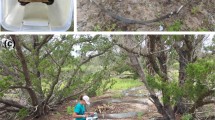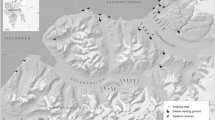Abstract
Breeding close to top predators is a widespread reproductive strategy. Breeding animals may gain indirect benefits if proximity to top predators results in a reduction of predation due to suppression of mesopredators. We tested if passerine birds gain protection from mesopredators by nesting within territories of a top predator, the Ural owl (Strix uralensis). We placed nest boxes for pied flycatchers (Ficedula hypoleuca) in Ural owl nest sites and in control sites (currently unoccupied by owls). The nest boxes were designed so that nest predation risk could be altered (experimentally increased) after flycatcher settlement; we considered predation rate as a proxy of mesopredator abundance. Overall, we found higher nest predation rates in treatment than in control sites. Flycatcher laying date did not differ between sites, but smaller clutches were laid in treatment sites compared to controls, suggesting a response to perceived predation risk. Relative nest predation rate varied between years, being higher in owl nest sites in 2 years but similar in another; this variation might be indirectly influenced by vole abundance. Proximity to Ural owl nests might represent a risky habitat for passerines. High predation rates within owl territories could be because small mesopredators that do not directly threaten owl nests are attracted to owl nest sites. This could be explained if some mesopredators use owl territories to gain protection from their own predators, or if top predators and mesopredators independently seek similar habitats.


Similar content being viewed by others
References
Bêty J, Gauthier G, Giroux J-F, Korpimäki E (2001) Are goose nesting success and lemming cycles linked? Interplay between nest density and predators. Oikos 93:388–400
Bêty J, Gauthier G, Korpimäki E, Giroux J-F (2002) Shared predators and indirect trophic interactions: lemming cycles and arctic-nesting geese. J Anim Ecol 71:88–98
Blanco G, Tella JL (1997) Protective association and breeding advantages of choughs nesting in lesser kestrel colonies. Anim Behav 54:335–342
Caro T (2005) Antipredator defences in birds and mammals. University of Chicago Press, Chicago
Chalfoun AD, Martin TE (2010) Parental investment decisions in response to ambient nest-predation risk versus actual predation on the prior nest. Condor 112:701–710
Czeszczewik D (2004) Breeding success and timing of the pied flycatcher Ficedula hypoleuca nesting in natural holes and nest-boxes in the Bialowieza forest. Poland Acta Ornithol 39:15–20
Doligez B, Clobert J (2003) Clutch size reduction as a response to increased nest predation rate in the collared flycatcher. Ecology 84:2582–2588
Eggers S, Griesser M, Nystrand M, Ekman J (2006) Predation risk induces changes in nest-site selection and clutch size in the Siberian Jay. Proc R Soc Lond B 273:701–706
Elmhagen B, Ludwig G, Rushton SP, Helle P, Linden H (2010) Top predators, mesopredators and their prey: interference ecosystems along bioclimatic productivity gradients. J Anim Ecol 79:785–794
Haemig PD (1999) Predation risk alters interactions among species: competition and facilitation between ants and nesting birds in a boreal forest. Ecol Lett 2:178–184
Haemig PD (2001) Symbiotic nesting of birds with formidable animals: a review with applications to biodiversity conservation. Biodivers Conserv 10:527–540
Hakkarainen H, Korpimaki E (1996) Competitive and predatory interactions among raptors: an observational and experimental study. Ecology 77:1134–1142
Häkkilä M, Halme P, Koskela E (2011) Could fluctuating prey availability change protective nesting associations in forest birds?—a hypothesis. J Ornithol 153:199–203
Heinze G (2006) A comparative investigation of methods for logistic regression with separated or nearly separated data. Stat Med 25:4216–4226
Jäderholm K (1987) Diet of the Tengmalm’s owl Aegolius funereus and the Ural owl Strix uralensis in Central Finland. Ornis Fenn 64:149–153
King EN, Ryan TP (2002) A preliminary investigation of maximum likelihood logistic regression versus exact logistic regression. Am Stat 56:163–170
Kontiainen P, Pietiäinen H, Huttunen K, Karell P, Kolunen H, Brommer JE (2009) Aggressive Ural owl mothers recruit more offspring. Behav Ecol 20:789–796
Korpimäki E, Sulkava S (1987) Diet and breeding performance of Ural owls Strix uralensis under fluctuating food conditions. Ornis Fenn 64:57–66
Korpimäki E, Huhtala K, Sulkava S (1990) Does the year-to-year variation in the diet of eagle and Ural owls support the alternative prey hypothesis? Oikos 58:47–54
Korpimäki E, Norrdahl K, Rinta-Jaskari T (1991) Responses of stoats and least weasels to fluctuating food abundances: is the low phase of the vole cycle due to mustelid predation? Oecologia 88:552–561
Korpimäki E, Norrdahl K, Huitu O, Klemola T (2005) Predator-induced synchrony in population oscillations of co-existing small mammal species. Proc R Soc Lond B 272:193–202
Larsen T (2000) Influence of rodent density on nesting associations involving the bar-tailed godwit Limosa lapponica. Ibis 142:476–481
Larsen T, Grundetjern S (1997) Optimal choice of neighbours: predator protection among tundra birds. J Avian Biol 28:303–308
Lima SL (2009) Predators and the breeding bird: behavioural and reproductive flexibility under the risk of predation. Biol Rev 84:485–513
Lundberg A (1981) Population ecology of the Ural owl Strix uralensis in Central Sweden. Ornis Scand 12:111–119
Lundberg A, Alatalo RV (1992) The pied flycatcher: mating and reproductive strategies. Poyser, London
Martin Andres A, Tapia Garcia JM (1999) Optimal unconditional test in 2 × 2 multinomial trials. Stat Data Anal 31:311–321
Mitrus C (2003) A comparison of the breeding ecology of collared flycatchers nesting in boxes and natural cavities. J Field Ornithol 74:293–299
Mönkkönen M, Husby M, Tornberg R, Helle P, Thomson RL (2007) Predation as a landscape effect: the trading off by prey species between predation risks and protection benefits. J Anim Ecol 76:619–629
Morosinotto C, Thomson RL, Korpimäki E (2010) Habitat selection as an antipredator behaviour in a multi-predator landscape: all enemies are not equal. J Anim Ecol 79:327–333
Morris DW (2003) Toward an ecological synthesis: a case for habitat selection. Oecologia 136:1–13
Mukherjee S, Zelcer M, Kotler BP (2009) Patch use in time and space for a meso-predator in a risky world. Oecologia 159:661–668
Norrdahl K, Suhonen J, Hemminki O, Korpimäki E (1995) Predator presence may benefit: kestrels protect curlew nests against nest predators. Oecologia 101:105–109
Pakkala T, Kouki J, Tiainen J (2006) Top predators and interference competition modify the occurrence and breeding success of a specialist species in a structurally complex forest environment. Ann Zool Fenn 43:137–164
Pietiäinen H (1989) Seasonal and individual variation in the production of offspring in the Ural owl Strix uralensis. J Anim Ecol 58:905–920
Polis GA, Holt RD (1992) Intraguild predation: the dynamics of complex trophic interactions. Trends Ecol Evol 7:151–154
Purcell KL, Berner J, Oring LW (1997) A comparison of the breeding ecology of birds nesting in boxes and tree cavities. Auk 114:646–656
Quinn JL, Kokorev Y (2002) Trading-off risks from predators and from aggressive hosts. Behav Ecol Sociobiol 51:455–460
Quinn JL, Ueta M (2008) Protective nesting associations in birds. Ibis 150:146–167
Ritchie EG, Johnson CN (2009) Predator interactions, mesopredator release and biodiversity conservation. Ecol Lett 12:982–998
Salo P, Nordström M, Thomson RL, Korpimäki E (2008) Risk induced by a native top predator reduces alien mink movements. J Anim Ecol 77:1092–1098
Selonen V, Sulkava P, Sulkava R, Sulkava S, Korpimäki E (2010) Decline of flying and red squirrels in boreal forests revealed by long-term diet analyses of avian predators. Anim Conserv 13:579–585
Seppänen J-T, Forsman JT, Mönkkönen M, Thomson RL (2007) Social information use is a process across time, space, and ecology, reaching heterospecifics. Ecology 88:1622–1633
Sergio F, Hiraldo F (2008) Intraguild predation in raptor assemblages: a review. Ibis 150:132–145
Sergio F, Marchesi L, Pedrini P, Penteriani V (2007a) Coexistence of a generalist owl with its intraguild predator: distance-sensitive or habitat-mediated avoidance? Anim Behav 74:1607–1616
Sergio F, Blas J, Forero MG, Donázar JA, Hiraldo F (2007b) Sequential settlement and site dependence in a migratory raptor. Behav Ecol 18:811–821
Smith PA, Gilchrist HG, Smith JNM, Nol E (2007) Annual variation in the benefits of a nesting association between red phalaropes (Phalaropus fulicarius) and Sabine’s gulls (Xema sabini). Auk 124:276–290
Thomson RL, Forsman JT, Sardà-Palomera F, Mönkkönen M (2006) Fear factor: prey habitat selection and its consequences in a predation risk landscape. Ecography 29:507–514
Trujillo-Ortiz A, Hernandez-Walls R, Castro-Perez A, Rodriguez-Cardozo L (2004) Barnardextest. A MATLAB file. http://www.mathworks.com/matlabcentral/fileexchange/loadFile.do?objectId=6198
Ueta M (1994) Azure-winged magpies, Cyanopica cyana, “parasitize” nest defence provided by Japanese lesser sparrowhawks, Accipiter gularis. Anim Behav 48:871–874
Verhulst S, Nilsson J-Å (2008) The timing of birds’ breeding seasons: a review of experiments that manipulated timing of breeding. Philos Trans R Soc Lond B 363:399–410
Weidinger K (2002) Interactive effects of concealment, parental behaviour and predators on the survival of open passerine nests. J Anim Ecol 71:424–437
Weidinger K, Kočvara R (2010) Repeatability of nest predation in passerines depends on predator species and time scale. Oikos 119:138–146
Zanette L (2004) What do artificial nests tells us about nest predation? Biol Conserv 103:323–329
Acknowledgments
We are thankful to Mari Laine, Eric Le Tortorec, Jorma Nurmi, Stefan Siivonen, Rauno Varjonen and Ville Vasko for extensive help with the field work. We are also grateful to Janne-Tuomas Seppänen for the help with statistical analyses and Alexandre Villers for useful comments on the manuscript. This project was supported by the Finnish Cultural Foundation, South Ostrobothnia Regional fund, The Turku University Foundation, the Ella and Georg Ehrnrooth foundation and the Biological Interactions Graduate School (personal grants to C.M.), the Kone foundation and Academy of Finland (Project No. 138049 to R.L.T.), and the Academy of Finland (to E.K.).
Author information
Authors and Affiliations
Corresponding author
Additional information
Communicated by Christopher Johnson.
Rights and permissions
About this article
Cite this article
Morosinotto, C., Thomson, R.L., Hänninen, M. et al. Higher nest predation risk in association with a top predator: mesopredator attraction?. Oecologia 170, 507–515 (2012). https://doi.org/10.1007/s00442-012-2320-1
Received:
Accepted:
Published:
Issue Date:
DOI: https://doi.org/10.1007/s00442-012-2320-1




